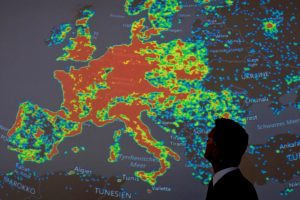When residents of Hawaii fled the massive eruption of the Kilauea volcano in May 2018, volcanologist Cheryl Gansecki and colleagues grabbed a homemade metal shield, tough boots, and shovels. The blast was a once-in-a-lifetime opportunity to do some amazing science—the Super Bowl of volcanoes.
Today, Gansecki and two other squads of scientists have published their findings from that extraordinary eruption, which lasted four months, destroyed 700 homes, and forced several thousand people to evacuate. The three papers published today in the journal Science give a deeper understanding of Kilauea’s underground plumbing system and explain how the caldera collapsed before the eruption began.
Gansecki, at the University of Hawaii at Hilo, has been studying volcanoes her entire career, and Kilauea in particular for the past 23 years. So as the lava poured across the eastern part of the Big Island, Gansecki donned her boots, a protective suit, and a mask, and lugged a shovel and hunk of metal roofing out onto the hardened sections of the flow. There she and a partner shoveled lava into a bucket of water to cool it down, while a third colleague kept a lookout for exploding balls of fire.
“Collecting lava is the fun part,” she says. (Not everyone may agree, but she loves volcanoes so much she even developed an eruption-predicting board game with her husband, also a volcanologist.)
Looking into the lava lake at Kilauea’s summit on May 6, before the caldera began to collapse.
Photograph: Kyle Anderson/U.S. Geological SurveyFor catching samples in the big rivers of lava, the team deployed a long pole and chain with a metal hook on the end, “like fishing,” Gansecki says. These big rivers of lava sometimes flowed 20 mph for more than 25 miles.
As part of her study, Gansecki and her team used a near real-time geochemical monitoring system to forecast when the lava was about to shift in consistency from thick, molasses-like flows to a super-hot river of fire. By figuring out the lava’s temperature quickly, they were able to provide important data to emergency response officials about its speed—and level of threat. It was the first time such a rapid monitoring system was used during a volcanic eruption.
The key was differentiating between older, slower-moving lava oozing through cracks and fissures in the Earth and fresher, hotter lava that likely was being pumped up from far below the surface. (The term magma refers to molten rock stored underground; it’s called lava when it emerges on the surface.)
Measuring the temperature of lava (somewhere between 1,500 and 2,000 degrees Fahrenheit) isn’t easy. Most thermometers either melt or just aren’t practical in the field, so other methods must be devised. Gansecki’s team took its samples to a nearby lab to run them through a device called an energy dispersive x-ray fluorescence spectrometer.
As lava cools, it crystallizes. So the researchers dunked the samples in water to stop the crystal growth. The team then dried and crushed the hardened lava to a powder and pressed it into pellets, which were bombarded with x-rays in the spectrometer. The x-rays cause elements in a sample to fluoresce at distinctive energy levels, making it possible to identify and measure them. The amounts of magnesium and calcium correlate with the lava’s maximum temperature.
Each set of samples took only about 20 minutes to run, and the chemical and temperature data was quickly relayed to scientists 35 miles away monitoring the flows on the scene.
The process proved an important predictor. After the initial eruption began, the temperatures began to increase, says Gansecki, and sometimes the hotter lava came out in unexpected places in the volcanic zone.
Thermal time-lapse of the lava lake, which fell by nearly 1,000 feet in about two weeks until an explosion terminated the video.
Video: Matthew Patrick/U.S. Geological SurveyMeanwhile, at the volcano’s caldera, another research team was flying drones to collect digital images as the structure collapsed several hundred feet each day. “This was the world’s best-documented caldera collapse,” says Kyle Anderson, a US Geological Survey geophysicist. “We could really witness these processes at close range.”
An old lava lake at the summit of the mountain was connected to the shallow plumbing system of magma below, Anderson says. The caldera deflated as magma drained away from the summit, sort of like water down a bathtub with a 20-mile drainpipe. “The lava lake was dropping 150 feet per day,” says Anderson, who is the lead author on the second paper published today in Science.
He and his team used drone images and satellite data to assemble a three-dimensional digital map of the lake’s surface, which gave them valuable information about what was happening with the magma below; the height of the lake reflected the pressure of the reservoir below.
A third paper, published by the USGS’ Michael Patrick and colleagues, showed how magna surges in fissures far away changed the pressure in the caldera at the summit.
Because the Kilauea eruption happened in a place where so many scientists could work safely, and run back to their lab to analyze data quickly, the researchers say they learned a lot more than any other recent eruption. They’re hoping their studies will give them a better idea of how other volcano plumbing systems work, and how better to warn people who live nearby.
More Great WIRED Stories
- Everything you need to know about genetic testing
- The strange life and mysterious death of a virtuoso coder
- Alphabet’s dream of an “Everyday Robot” is just out of reach
- Wish List 2019: 52 amazing gifts you’ll want to keep for yourself
- How to lock down your health and fitness data
- 👁 A safer way to protect your data; plus, the latest news on AI
- 🏃🏽♀️ Want the best tools to get healthy? Check out our Gear team’s picks for the best fitness trackers, running gear (including shoes and socks), and best headphones.



